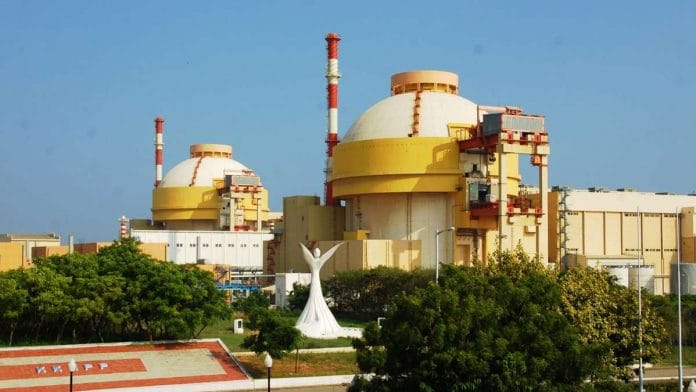New Delhi: The construction work for unit 5 of the Kudankulam Nuclear Power Plant (KKNPP) began Tuesday with the first pouring of concrete into the foundation plate of the reactor building.
The flagship Indo-Russian project altogether envisages six units, each with a capacity of 1,000 MW, of which two are already active.
Weighing in on the first pour, Russian Ambassador to India Nikolay Kudashev said it was “one of the significant moments in the Russia-India energy cooperation”.
1st pour of concrete at the construction site of the 5th nuclear reactor of #Kudankulam NPP, happened today, is one of significant moments in the #RussiaIndia nuclear energy cooperation. It demonstrates our firm devotion to achieve success in all bilateral undertakings. pic.twitter.com/ijLTuS1FeF
— Nikolay Kudashev ?? (@NKudashev) June 29, 2021
Russian company Rosatom is providing the technology for the construction of the plant.
India and Russia’s agreement on nuclear power envisions building as many as 12 nuclear plants by 2035.
Nuclear energy is clean in nature — with none of the adverse impacts linked to fossil fuels — but associated with potential health hazards because of the radioactive waste generated. However, advocates of the technology note that the chance of an accident — and thus a leak — is low, and that the impact on people can be avoided.
The Kudankulam plant has been the target of at least two episodes of protest, including one emerging from concerns raised by the Fukushima incident in 2011, when a powerful earthquake and tsunami set the stage for a radiation leak from a nuclear plant that led to the evacuation of thousands of residents from the area around.
Also Read: Tarapur, India’s 2nd most powerful nuclear plant built with US help, completes 50 yrs today
History of Kudankulam nuclear power plant
The Kudankulam Nuclear Power Plant (KKNPP) was the outcome of a 1988 inter-governmental agreement between the erstwhile Soviet Union and India. Then prime minister Rajiv Gandhi and Soviet president Mikhail Gorbachev signed the Kudankulam agreement, which was initially aimed to set up two nuclear reactors in Tirunelveli.
The dissolution of the Soviet Union delayed the project and it was revived after a supplementary agreement was signed on 21 June 1998 in New Delhi by Russian Minister for Atomic Energy Yevgeny Adamov and Atomic Energy Commission (AEC) Chairman R. Chidambaram.
Under the agreement, Russia is required to manufacture and deliver important components for the power plant and provide technical support. Russia has also extended credit support for the project over the years.
The first pour of concrete for units 1 and 2 took place at Kudankulam on 31 March, 2002. The project was six months ahead of schedule and was supposed to begin functioning by March 2007 but fell behind because of delays in the supply of designs and equipment by Russia.
Work on the project was delayed further by the 2011 protests against the plant. The first unit eventually reached criticality on 13 July 2013, and full-capacity generation (1,000 MW) in 2014.
In India, Kudankulam, located near the country’s tip to the south, is the highest-capacity nuclear power plant. India’s present installed nuclear power capacity is 6,780 MW through 22 reactors. The cost of power generation from KKNPP is Rs 4.10 per unit.
Protests against KKNPP
In 1990, soon after the project was announced, the first protest against it was held by fishermen and local residents who were concerned about the diversion of water for the reactors from the Pechiparai dam in Kanyakumari district.
In 2012, project officials dismissed the local residents’ fears and said an ultra-mega desalination plant at the project site would supply the fresh water required to manage the day-to-day operations of the reactors.
In March 2011, right when India began testing equipment at the first nuclear power unit, protests erupted in the aftermath of the Fukushima nuclear disaster in Japan, with protesters raising concerns about the safety of the plant.
Hundreds of protesters, led by S.P. Udayakumar and his People’s Movement against Nuclear Energy (PMANE), were booked for “sedition”.
The PMANE and others filed petitions in the Madras High Court, arguing that 17 recommendations of an expert government task force were not strictly followed by the operator, the Nuclear Power Corporation of India Limited (NPCIL), but the court gave its go-ahead for the project. The Supreme Court, where the order was challenged, dismissed the petitions as well in 2013. Nuclear energy, the court said, is the need of future and present generations.
In May 2013, 60 eminent scientists petitioned the chief ministers of Tamil Nadu and Kerala, requesting them to demand an independent safety audit of Kudankulam.
Also Read: China’s nuclear leak is no Chernobyl, but how it was handled is troubling






